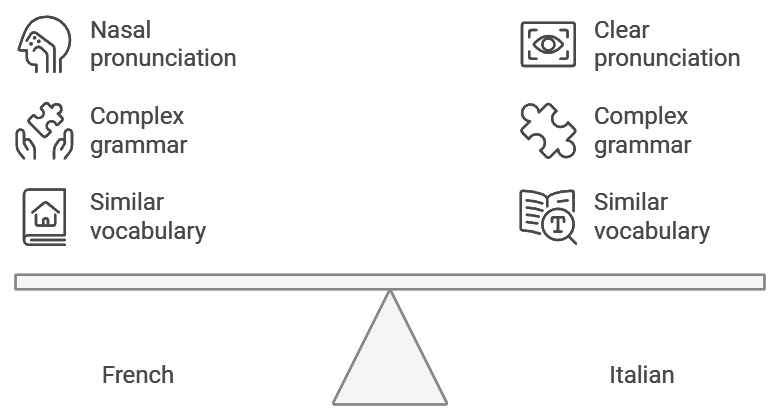Can You Learn French and Italian at the Same Time?
Yes, you can learn French and Italian simultaneously, especially since they share Latin roots and many similar structures. However, success requires the right strategy, dedication, and understanding of how to manage both languages effectively.
Key Takeaways
- Learning French and Italian together enhances cognitive abilities and memory
- Scientific research shows simultaneous language learning improves brain plasticity
- Success requires 1-2 hours of daily practice for each language
- Using different learning environments for each language reduces confusion
- Career opportunities increase significantly with Romance language proficiency
- Regular assessment and tracking prevent language interference
The Science Behind Dual Language Learning
Recent neuroscience research reveals fascinating insights about learning two Romance languages simultaneously. When you study French and Italian together, your brain creates new neural pathways that enhance:
- Memory retention
- Problem-solving abilities
- Mental flexibility
- Cultural awareness
- Cognitive processing speed
Studies show that learning related languages activates similar brain regions, making it easier to understand patterns and connections between them.
Comparing French and Italian
Here’s a comparative analysis of both languages to help you understand their relationship:
| Feature | French | Italian | Learning Impact |
|---|---|---|---|
| Pronunciation | More nasal sounds | Clear vowel sounds | Different practice needed |
| Grammar Structure | More complex | More straightforward | Start with Italian basics |
| Verb Conjugation | Many irregular verbs | More regular patterns | Learn French verbs first |
| Vocabulary Overlap | 85% Latin-based | 75% Latin-based | Many shared cognates |
Practical Learning Strategy
Daily Schedule Structure
- Morning: Focus on French grammar and vocabulary
- Afternoon: Practice Italian pronunciation
- Evening: Cultural immersion activities in both languages
Progress Tracking Methods
- Keep separate language journals
- Use spaced repetition software
- Record speaking exercises
- Take monthly assessment tests
Technology and Tools Integration
Modern language learning benefits from specialized tools:
- AI-powered language apps (Duolingo, Babbel)
- Video platforms with dual subtitles
- Language exchange apps (Tandem, HelloTalk)
- Podcast platforms with transcripts
Professional Applications
The demand for French-Italian bilingual speakers continues to grow in:
- International business
- Diplomatic services
- Tourism and hospitality
- Translation and interpretation
- Cultural exchange programs
Salary Impact: Bilingual professionals earn 10-15% more than monolingual counterparts in similar positions.
Cultural Integration Methods
Immerse yourself in both cultures through:
- Watching films in original language
- Reading news from both countries
- Participating in language exchange meetups
- Following social media influencers from both cultures
- Attending cultural events
Common Challenges and Solutions
Language Interference
- Use color-coding for study materials
- Practice one language per day
- Create separate learning environments
- Use different accents as memory triggers
Time Management
- Set realistic daily goals
- Use time-blocking techniques
- Focus on one skill per session
- Maintain a consistent schedule

Success Metrics and Timeline
Expect the following milestones:
3 Months
- Basic conversations in both languages
- Understanding of fundamental grammar
- 500 words vocabulary in each language
6 Months
- Intermediate reading comprehension
- Basic writing skills
- 1000+ words vocabulary in each language
12 Months
- Advanced conversation abilities
- Complex grammar mastery
- 2000+ words vocabulary in each language
Assessment Methods
Track your progress through:
- Regular self-assessment tests
- Language proficiency exams
- Recording speaking exercises
- Writing journal entries
- Peer evaluation in language exchange groups
Remember that success in learning both French and Italian simultaneously depends largely on consistent practice, proper organization, and maintaining motivation through measurable progress. With dedicated study and the right approach, you can achieve fluency in both languages within 12-18 months of consistent practice.
